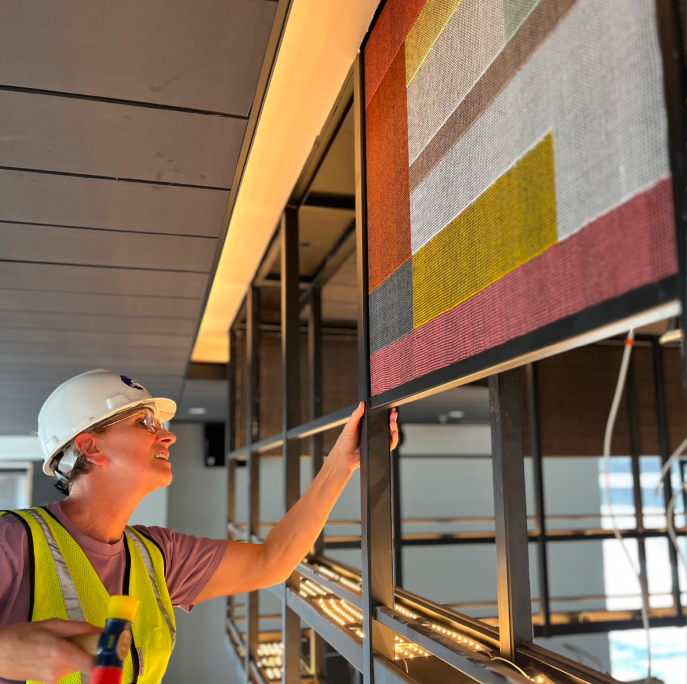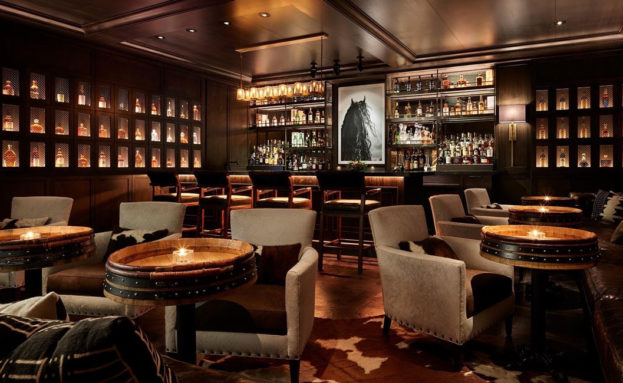As part of our ongoing series exploring “The Art of Curiosity,” we sat down with the talented weaver who created the stunning bar canopy at Kimpton Santo in San Antonio. Her four-panel installation tells the story of the city from every direction, honoring the rich cultural heritage that defines this historic Texas destination.
Tell us about your piece at Kimpton Santo. What was the inspiration behind the bar canopy?
I had the honor of being selected to weave the four sides of the bar canopy at the Kimpton Hotel. Positioned between the reception area and the restaurant, the bar features woven panels spanning 2.5 feet by 11 feet, with five panels on each side, forming the canopy.
My inspiration came from the hotel’s unique location, bridging two historically significant districts—King William to the south and La Villita to the north. King William’s land was once irrigated farmland belonging to Mission San Antonio de Valero (the Alamo) before being distributed to Coahuiltecan peoples in 1793 and later sold to developers in the 1840s. La Villita, San Antonio’s oldest neighborhood, evolved from a Native American settlement to a Spanish military post and later became a hub for European immigrants and artisans. Today, it thrives as an arts and crafts community.

With this rich history in mind, I designed each side of the canopy to reflect the city’s past and present from all four directions:
South – San Antonio is the largest majority-Hispanic city in the U.S., with deep ties to Mexico. To honor this heritage, I wove the south panel in the style of a sarape, a traditional Mexican shawl, using its bold colors and patterns.
West – Just three blocks west of the hotel, the San Antonio River has long been the city’s lifeline, fueling commerce and industry. I wove an abstract aerial view of the river, capturing its winding presence across the panels.
North – The Texas Hill Country lies to the north, where wildflowers blanket the landscape each spring. These vibrant fields reminded early German settlers of their homeland. Adjacent to the historic German School, built in 1858, this panel honors its legacy through woven floral motifs.
East – San Antonio’s east side has always been a melting pot of cultures, evolving through waves of settlement, military influence, and ongoing revitalization. To reflect its diversity and transformation, I wove this panel in the style of a crazy quilt, blending colors and patterns in a dynamic composition.
By incorporating these elements, I hope viewers connect with the history woven into this city—literally and figuratively. My favorite part of this project is how it captures the essence of San Antonio from all four directions, celebrating the stories and people who have shaped it.

What was your creative process like? Can you speak to the collaborative aspects of working with KBAA?
My process was guided by clear communication and collaboration. I worked closely with Veronica Volborth, the art director, who made the entire experience smooth by facilitating discussions and providing valuable feedback. She submitted my ideas and woven samples to the team, ensuring that expectations were aligned and allowing me to focus on the creative and technical aspects of the work.
In terms of materials, I carefully selected fibers that would be both durable and visually engaging, considering how they would interact with the hotel space. Once the weaving was complete, I collaborated with my fabricator to stretch the panels over wooden frames. We worked together to ensure the finished pieces maintained their structural integrity while remaining lightweight and visually seamless. This partnership was essential in bringing the final installation to life in a way that honored both the woven medium and the space it was designed for.
How does curiosity play a role in your artistic practice?
I love to tell stories through my weaving. The weaving process itself creates connections—both structurally and thematically—which makes it a perfect medium for exploration and discovery. For my commission at Kimpton Santo, I immersed myself in San Antonio’s history, location, and cultural heritage, letting those elements shape my work.
While weaving for this project, I took a short trip to Mexico City. One morning, as I walked to breakfast, I passed a Kimpton Hotel and was immediately drawn inside by its unique artwork. In that moment, I wondered if someone might one day do the same—be pulled into the Kimpton Santo in San Antonio by curiosity about my woven panels.
Art offers the gift of a fresh perspective. I hope that those who see my work will feel inspired to look more closely, to ask questions, and perhaps even to explore—whether that means strolling along the River Walk or venturing into the Texas Hill Country.
What draws you to working with textiles and weaving?
I have a deep appreciation for textiles and love the process of creating them. Weaving allows me to manipulate structures and experiment with a diverse range of fibers—rigid sticks, plastic bags, pineapple fiber, silk, wire, bamboo, and cotton—all of which bring unique textures and unexpected outcomes when combined. I also repurpose materials like clothing and curtains, tearing them into strips because they feel just right for a particular weaving. When I can’t find the exact color I need, I dye it myself.
This process is incredibly exciting to me. At the loom, I lose myself completely, forgetting space and time as I explore the endless possibilities of texture and form.

Tell us about your journey as an artist. How did you discover weaving?
My artistic journey is profoundly influenced by the pioneering spirit of the Bauhaus women weavers. These remarkable individuals, largely self-taught, approached their craft with an open-mindedness free of preconceived notions, embracing experimentation as a fundamental part of their process. Their dedication to learning through trial and error deeply resonates with my own path as a predominantly self-taught artist.
In 2009, Berlin hosted the Bauhaus. A Conceptual Model exhibition, a collaborative effort by Bauhaus research institutions and museums in Germany to celebrate the 90th anniversary of the movement and its lasting impact on architecture and design. While strolling through this extensive exhibition on a rainy day, I fell in love with Anni Albers’ weavings. I examined them closely, then walked straight to the bookstore, eager to read more about her and the weaving practices at Bauhaus.
When I returned to San Antonio, I enrolled in weaving classes at what was then the Southwest School of Art and continued there for seven years. My motto was simple: I only wanted to experiment—not to weave anything practical or useful. In 2017, during a six-month residency, I realized that I was most productive when working alone. I reorganized my home, making space for three looms and transforming spare bedrooms into storage and packaging areas. I have never regretted that decision.
I am fortunate to be able to travel and visit incredible woven works across different countries. These experiences continue to inspire and influence my own creative process.

The bar canopy at Kimpton Santo stands as a testament to the power of art to tell stories and connect communities. Through her thoughtful exploration of San Antonio’s multicultural heritage, Doerte Weber has created a work that invites guests to discover the rich tapestry of history that surrounds them.


